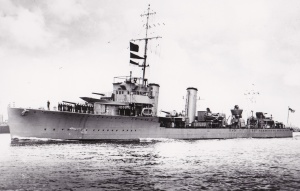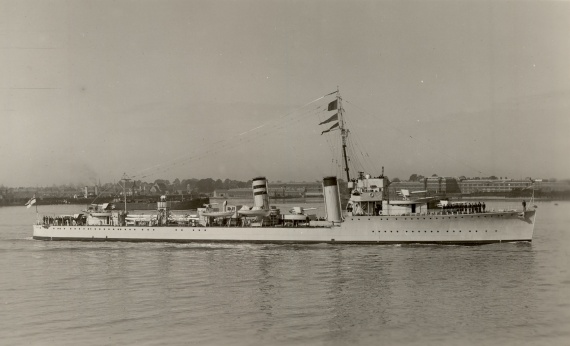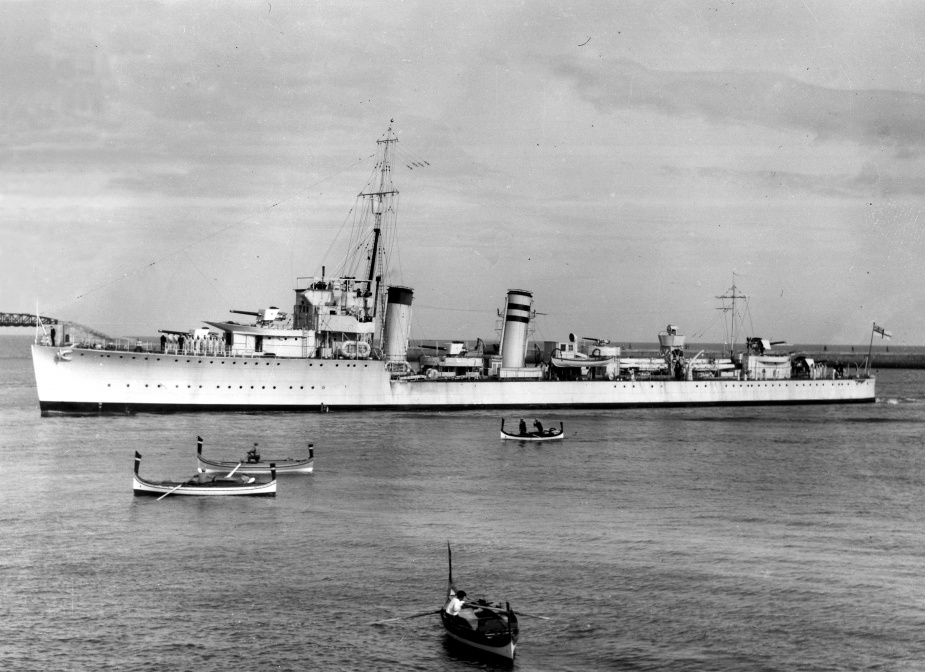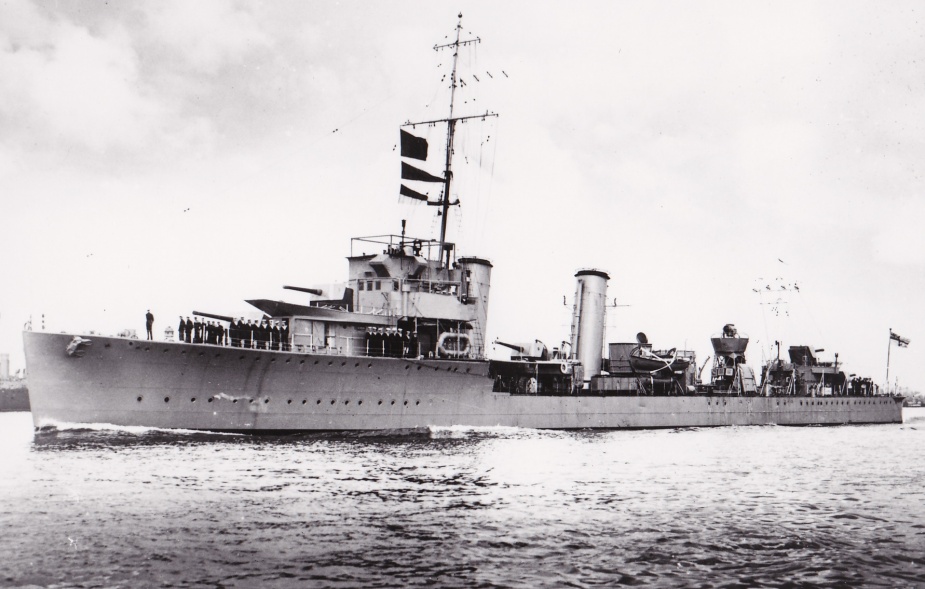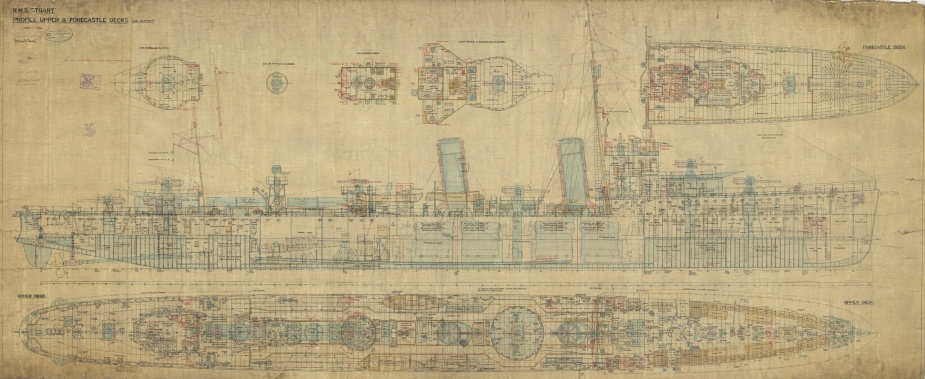HMAS Stuart (I)
| Class |
Scott Class |
|---|---|
| Type |
Destroyer (Flotilla Leader) |
| Pennant |
D00 |
| Builder |
RW Hawthorne, Leslie and Co Ltd, Hebburn-on-Tyne, England |
| Laid Down |
18 October 1917 |
| Launched |
22 August 1918 |
| Commissioned |
11 October 1933 |
| Decommissioned |
27 April 1946 |
| Dimensions & Displacement | |
| Displacement | 1530 tons |
| Length | 332 feet 6 inches |
| Beam | 31 feet 9 inches |
| Draught | 11 feet 4 inches |
| Performance | |
| Speed | 36.5 knots |
| Propulsion | |
| Machinery | Brown Curtis turbines |
| Horsepower | 40,000 |
| Armament | |
| Guns |
|
| Torpedoes | 6 x 21-inch torpedo tubes (two triple mountings) |
| Awards | |
| Battle Honours | |
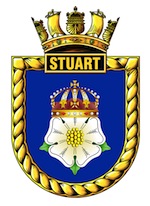
HMAS Stuart was one of nine Scott Class Destroyer Flotilla Leaders built between 1917 and 1919 under the British Government's Wartime Emergency Construction Programme. Four of them (Scott, Bruce, Douglas and Montrose) were completed before the end of hostilities in November 1918. Scott was sunk by a German submarine off the Dutch coast on 15 August 1918. The remainder (Mackay, Malcolm, Campbell, Keppel and Stuart) were completed between December 1918 and 1920. Bruce was scrapped in the thirties but all the others served in and survived World War II.
From her commissioning in the Royal Navy on 21 December 1918 until she finally paid off in May 1933, most of Stuart's seagoing service with the Royal Navy was spent on the Mediterranean Station as a unit of the 2nd Destroyer Flotilla.
In 1933 the Admiralty agreed to loan the Flotilla Leader Stuart and four V and W Class destroyers (Vampire (I), Vendetta (I), Voyager (I) and Waterhen (I)) to the Royal Australian Navy as replacements for the S Class destroyers (Stalwart (I), Success, Swordsman, Tasmania and Tattoo) and the Flotilla Leader Anzac (I), then due for scrapping. Stuart and the other four ships commissioned in the Royal Australian Navy at Portsmouth on 11 October 1933 to form the Australian Destroyer Flotilla, later to become famous as the 'Scrap Iron Flotilla'.
The Flotilla departed Chatham, under the command of Captain AC Lilley RN (in Stuart), on 17 October 1933 and, proceeding via Suez, reached Singapore on 28 November, Darwin on 7 December and Sydney on 21 December 1933.
Stuart served on the Australia Station until 1 June 1938 when she paid off at Sydney. She recommissioned for a short period at the time of the Munich Crisis (29 September 1938 to 30 November 1938).
With the outbreak of war Stuart recommissioned on 1 September 1939 under the command of Commander HML Waller RAN. Stuart's first wartime duties were anti-submarine patrols based on Sydney, alternating with Vendetta (I) and Waterhen (I).
On 14 October 1939, in company with Vendetta (I) and Waterhen (I), Stuart departed Sydney for Singapore, proceeding via Darwin and Lombok Strait. The same day Vampire (I) and Voyager (I) departed Fremantle to join company at Singapore. The Flotilla was under the command of Commander HML Waller RAN (Commander (D)), in Stuart.
It had been intended to base the destroyers at Singapore for a period of training but, while the Flotilla was still at sea, it was decided that after a brief stop at Singapore it should proceed to the Mediterranean. The two ships ex Fremantle arrived at Singapore on 21 October 1939 where they were joined on 29 October by Stuart, Waterhen (I) and Vendetta (I).
The Flotilla sailed from Singapore on 13 November 1939 but split up en route and consequently the ships did not all reach Malta at the same time. Stuart arrived on 1 January 1940. From 2 January 1940 the Flotilla formed the 19th Destroyer Division for service with the Mediterranean Fleet.
At this period of the war, British and French naval supremacy in the Mediterranean called for only routine escort and patrol duties, interspersed with Fleet exercises. Nevertheless, the Australian destroyers were kept busy with their routine of escort and patrol work, singly and in pairs, which took them from end to end of the Mediterranean.
On 27 May 1940 the 19th Destroyer Division and the 20th Destroyer Division (HM Ships Dainty, Decoy, Defender and Diamond) combined forces to form the 10th Destroyer Flotilla under the command of Commander Waller.
The entry of Italy into the war on 10 June 1940 and the collapse of French resistance on 22 June completely changed the naval situation in the Mediterranean. Formerly, all coastlines were either Allied or neutral, and the Anglo-French Fleets were in undisputed command of the seas. Now all coasts except those of Egypt, Palestine and Cyprus in the east, Malta in the centre, and Gibraltar in the west were closed to the Royal Navy. Moreover, the Allies had lost the support of the French Fleet, which had provided seven capital ships and nineteen cruisers, and had acquired a new enemy in Italy with her menacing naval potential. Her fleet boasted five battleships, 25 cruisers, ninety destroyers and nearly one hundred submarines. It spelt the beginning of a long and bitter struggle for control of the Mediterranean, first against the Italian Fleet and Air Force (neither of which proved the menace expected) and later against the much more formidable German Luftwaffe whose dive bombers took grievous toll of British warships before they were finally driven from the skies.
For more than a year the 'Scrap Iron Flotilla' took part in the struggle for possession of the ancient sea route linking east and west. Stuart, in common with most of the Mediterranean Fleet destroyers in 1940 and 1941, was almost constantly at sea, if not operating with the fleet, then on the never ceasing duty of escort and patrol. She took part in all the main campaigns - Western Desert, Greece, Crete and Syria.
In the long sea-saw struggle in the Western Desert she served as a unit of the Inshore Squadron giving support to the British armies ashore. At other times operating with heavy fleet units she took part in several coastal bombardments of enemy strong points in Libya, including the first shelling of Bardia in June 1940.
In July 1940 Stuart led the 10th Destroyer Flotilla at the Battle of Calabria, the first fleet engagement in the Mediterranean since Nelson's time.
On 17 August 1940 Stuart was one of the destroyers screening the British battleships Warspite, Malaya and Ramillies and the cruiser Kent when they bombarded Italian troop concentrations in Libya at Capuzzo and near Bardia.
On the night of 29/30 September 1940 Stuart attacked the Italian submarine Gondar with depth charges. In the morning, by which time Stuart had the assistance of a Royal Air Force Sunderland flying boat and the trawler HMS Sindonis, the submarine commander was forced to surface and abandon his vessel, which then sank after the explosion of scuttling charges. Stuart and Sindonis rescued all but two of Gondar's crew.
Stuart, in company with Vampire (I), Voyager (I), the gunboat HMS Gnat and the monitor HMS Terror, supported the 6th Australian Division when it captured Tobruk on 22 January 1941.
In March 1941 she was present at and played a notable part in the Battle of Matapan, an engagement which ended in the decisive defeat of the enemy's fleet and a final shattering of any hopes the Italians may have had of challenging British naval supremacy in the Mediterranean.
In March and April 1941 Stuart was engaged in the transport of troops from Egypt to Greece.
Early in April, together with Vendetta (I), Voyager (I) and Waterhen (I), she bombarded enemy positions in North Africa in support of the Army and also assisted in supplying Tobruk. On 19 April Stuart, Voyager (I) and Waterhen (I) participated as escorts in a commando raid on Bardia by troops carried in the landing ship HMS Glengyle.
When the Greek campaign was finally seen to be a lost cause, Stuart assisted in the evacuation of Allied troops to Crete in April 1941. The following month she participated in the evacuation from Crete.
From 10 to 13 June 1941 Stuart was engaged in the Syrian campaign, patrolling in support of the inshore bombarding forces.
In May 1941 the regular 'Tobruk Ferry Service' for the supply and reinforcement of the beleaguered Australian garrison at Tobruk had been instituted by destroyers of the Inshore Squadron. Stuart joined the 'Tobruk Ferry Service' in June and during that month and July she made 24 runs.
These were highlights of Stuart';s part in the Mediterranean campaign representing only a small portion of her constant comings and goings over that war torn sea. She took part in numerous minor fleet operations and was particularly concerned with the safe passage of the many convoys east and west bound including those sent to maintain the key strategic island of Malta.
By mid-1941 the old destroyer was badly feeling the strain and if she was to remain in service an extensive refit had become imperative. She had survived more than fifty air attacks and was trembling in every rivet. On 25/26 July 1941 she made her final run to Tobruk and barely limped back to Alexandria. On 22 August, with her port engine out of commission, she sailed for Australia. Steaming on one engine she reached Fremantle on 16 September and Melbourne on 27 September where a long refit was begun which kept her in dockyard hands until April 1942.
In April 1942, under the command of Commander SHK Spurgeon RAN, she began a period of escort duty. At first her operations were confined mainly to the Australian coast but in October 1942 she began escorting convoys between Queensland ports and New Guinea. In March 1943 she returned to Australian coastal duty and remained in home waters until the close of the year.
In March and April 1945 she was converted to a store and troop carrying vessel and in this humbler role continued to give useful service in New Guinea and Australian waters until January 1946. In February 1946 Stuart passed through Sydney Heads as a seagoing vessel for the last time. Since commissioning for war service in September 1939 she had steamed almost one quarter of a million miles and had been more than 17,000 hours under way. No men were lost in her through enemy action.
Stuart paid off at Sydney on 27 April 1946. On 3 February 1947 she was sold to T Carr and Co Ltd of Sydney to be broken up.
Further reading
'Scrap Iron Destroyers: The Story of HMA Ships Stuart, Vampire, Vendetta, Voyager and Waterhen' by LJ Lind and A Payne - The Naval Historical Society of Australia, Garden Island, 1976.

